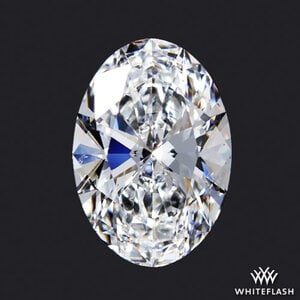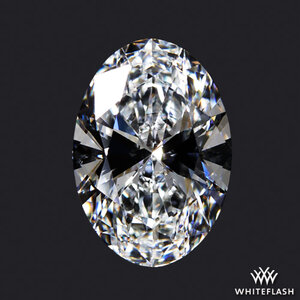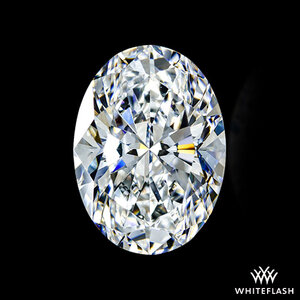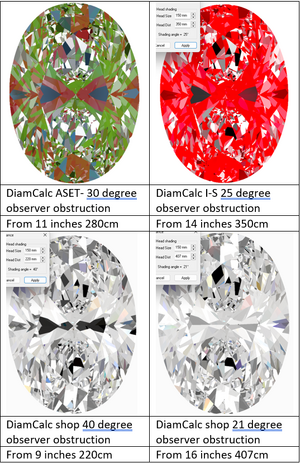- Joined
- Jul 27, 2009
- Messages
- 4,092
Evaluating cut quality in fancy shape diamonds is much more challenging than for the round brilliant. For one thing, GIA reports do not provide an overall cut grade for fancy shapes. This leaves consumers pretty much on their own to determine cut quality – a pretty daunting task. With the rise in popularity of oval shape diamonds one of the biggest topics of discussion is the “bowtie effect” which is an area across the midsection of an elongated fancy shape such as an oval or marquise that features a sideways hourglass shape made of virtual facets that are different from those in the ends of the stone. A pronounced bowtie can appear as in darkness in the middle of the stone or a disjointed combination of virtual facets. Naturally, shoppers want to know if the diamond they are considering has an acceptable bowtie.
The first thing to understand is that a bowtie tends to go with the territory of elongated fancy shapes such as oval diamonds. So, the question of whether a diamond has a bow ties is less a ‘yes/no’ question and more a matter of degree. And, as a bottom line, if the bowtie detracts from the visual appeal of the diamond. It’s also important to understand that images across the internet are taken with a wide variety of photo setups and lighting conditions that can both accentuate or minimize the appearance of the bowtie. Static photos can often make a bowtie look more unappealing than it is in real life considering the diamond is usually observed in motion.
Facet Design
The same shape diamond can have a variety of different facet arrangements. They can be essentially the same but altered in some way, such as brilliant and modified brilliant cuts. The specific facet design can have significant impacts on the virtual facet patterns and therefore the appearance of the diamond. But so can small variations in proportions and facet angles within the same design. This is why it is so hard to predict light performance based only on basic proportions and physical facet design. It is in the details that the answers are to be found. But even experts working with additional tools such as ASET can only predict the optics of a diamond. It’s an educated guess that most shoppers do not have the experience to make. The proof for the shopper, especially the internet shopper, is in high quality images and videos of the diamond. For the average shopper looking for a fancy shape today the best approach is to rely on expert guidance. Knowing the level of expertise and the reputation of your vendor is a big part of a successful purchase, especially in fancy shape diamonds.
Dark Bowties – Head Shadow
Some of the larger pavilion facets in the center of an oval (and other elongated fancies) tend to reflect light coming from the highest points overhead. Looking at a diamond at close range blocks some light from those high angles and head shadow can be reflected back to the eye resulting in darkness from those facets. The closer the viewing range the more light is blocked by your head. Images found on the internet often reproduce this effect as the black of the camera lens is reflected back in the image.
Images across the internet are taken with a wide range of equipment, camera setups and lighting. Depending on these many variables a bowtie may be appear accentuated or minimized. It may appear as darkness, or it may just be seen in a different virtual facet pattern coming from the midsection of the diamond. The two images below are the same diamond in the same lighting but with the camera closer and further away. As the camera is moved closer the darkness of the bowtie increases. A well cut diamond should be able to be observed at a normal viewing range while still appearing very bright.


Same diamond in same lighting with distance to the camera 12 inches (left) and 8 Inches (on right). The camera lens 52 mm in diameter.
Virtual Facet Structure
Because a bowtie will not always present in photos or videos as darkness, it is best to evaluate the facet structure. More precisely put, the virtual facet structure. A diamond creates many more sparkles that it has physical facets because a single facet can reflect light rays coming from multiple directions. The virtual facet patterns really what we experience and can vary dramatically even among diamonds of the same facet design. Small differences in proportions, length to width ratio, and facets angles and azimuths can give rise to significant variations in virtual facet patterns and the optics of the diamond.
It is therefore best to evaluate bowtie by focusing on the virtual facet pattern that we can see in photos, videos, and of course in person. A pronounced bowtie can make a diamond look like it was assembled by committee, with the ends separated by the midsection of the stone. Sometimes there is a noticeable disparity in the optical “flavor” of the facet pattern in the ends versus the center of the diamond. This disjointed look can detract from the overall visual appeal of the diamond.
The diamond photos below illustrate the difference between a stone with a harmonious pattern of virtual facets and one that is more disjointed. In real life both are very pretty diamonds, but the one with the better integrated and homogenous virtual facets has a more harmonious appearance.


Diamond on the left has a more harmonious virtual facet structure compared to the diamond on the right
Motion and Tilt
Static images sometimes make certain aspects of fancy shape diamonds look worse than they actually are. That is because diamond scintillation is dynamic and in the real world there is almost always motion involved, either on the part of the diamond or the observer or both. And diamonds are not always viewed straight up as a photo image typically is positioned.
Assessing bowtie and other aspects of face up appears is best done observing the diamond in motion through a small range of tilt angles.
Proportions Assessment
With so little for new diamond shopper to go on, there is a tendency to want to rely on a few measures found on a diamond report. But the rounded and averaged measurements of a few basic facet groups, do not paint the full picture of a diamond - they tell us relatively little about how the diamond actually performs. Having said that, there are things happening that may make it easier for shoppers today and in the future to make better informed choices with regard to fancy shapes.
IGI has recently begun offering overall cut grades on fancy shape diamonds. If their grading system for fancies is anything like their overall cut grade system for rounds, it is likely to be overly broad. And the final step in their assessment, according to their website, is a visual evaluation by a trained grader. But they also publish tables of proportions used in their cut grading, which could be useful to shoppers in order to find diamonds that are within safe ranges.
In addition, GIA through their acquisition of the AGSL light performance cut grading technology now has the most sophisticated tools yet developed to grade cut quality of fancy shapes. And GIA is already offering AGS Ideal reports on round AND fancy shape diamonds. But only on those diamonds that pass the rigorous AGSL ray tracer as Ideal Cut. And because there are not many manufacturers cutting to this high standard, there are not many such stones available in the market today. But that will almost certainly be changing over time. With major labs like IGI pushing in this direction, and with GIA now having the technology to perform actual light performance testing, there is every reason to expect cutting to improve and a full range of well cut fancy shaped diamonds with objectively obtained cut grades to become available on the market.
Conclusions
Bowties are a common feature of ovals, marquise, and other elongated fancy shape diamonds. They can often be distracting to the overall visual appeal of the diamond, and sometimes make they look dark in the middle. A prominent bow tie can make a diamond’s facet structure look disjointed, like the ends are separated by the midsection. For these reasons you want to avoid a stone that has a bow tie that is too prominent. A well cut diamond should have good brightness at normal viewing distances and when viewed in motion the facet structure should have a nice blend of virtual facets that result in harmonious light play. If your eye is drawn to the bowtie whenever you look at the diamond, it is probably too prominent.
Thoughts or questions about bow ties? How important do you think this aspect is to the overall visual appeal of diamonds?
The first thing to understand is that a bowtie tends to go with the territory of elongated fancy shapes such as oval diamonds. So, the question of whether a diamond has a bow ties is less a ‘yes/no’ question and more a matter of degree. And, as a bottom line, if the bowtie detracts from the visual appeal of the diamond. It’s also important to understand that images across the internet are taken with a wide variety of photo setups and lighting conditions that can both accentuate or minimize the appearance of the bowtie. Static photos can often make a bowtie look more unappealing than it is in real life considering the diamond is usually observed in motion.
Facet Design
The same shape diamond can have a variety of different facet arrangements. They can be essentially the same but altered in some way, such as brilliant and modified brilliant cuts. The specific facet design can have significant impacts on the virtual facet patterns and therefore the appearance of the diamond. But so can small variations in proportions and facet angles within the same design. This is why it is so hard to predict light performance based only on basic proportions and physical facet design. It is in the details that the answers are to be found. But even experts working with additional tools such as ASET can only predict the optics of a diamond. It’s an educated guess that most shoppers do not have the experience to make. The proof for the shopper, especially the internet shopper, is in high quality images and videos of the diamond. For the average shopper looking for a fancy shape today the best approach is to rely on expert guidance. Knowing the level of expertise and the reputation of your vendor is a big part of a successful purchase, especially in fancy shape diamonds.
Dark Bowties – Head Shadow
Some of the larger pavilion facets in the center of an oval (and other elongated fancies) tend to reflect light coming from the highest points overhead. Looking at a diamond at close range blocks some light from those high angles and head shadow can be reflected back to the eye resulting in darkness from those facets. The closer the viewing range the more light is blocked by your head. Images found on the internet often reproduce this effect as the black of the camera lens is reflected back in the image.
Images across the internet are taken with a wide range of equipment, camera setups and lighting. Depending on these many variables a bowtie may be appear accentuated or minimized. It may appear as darkness, or it may just be seen in a different virtual facet pattern coming from the midsection of the diamond. The two images below are the same diamond in the same lighting but with the camera closer and further away. As the camera is moved closer the darkness of the bowtie increases. A well cut diamond should be able to be observed at a normal viewing range while still appearing very bright.


Same diamond in same lighting with distance to the camera 12 inches (left) and 8 Inches (on right). The camera lens 52 mm in diameter.
Virtual Facet Structure
Because a bowtie will not always present in photos or videos as darkness, it is best to evaluate the facet structure. More precisely put, the virtual facet structure. A diamond creates many more sparkles that it has physical facets because a single facet can reflect light rays coming from multiple directions. The virtual facet patterns really what we experience and can vary dramatically even among diamonds of the same facet design. Small differences in proportions, length to width ratio, and facets angles and azimuths can give rise to significant variations in virtual facet patterns and the optics of the diamond.
It is therefore best to evaluate bowtie by focusing on the virtual facet pattern that we can see in photos, videos, and of course in person. A pronounced bowtie can make a diamond look like it was assembled by committee, with the ends separated by the midsection of the stone. Sometimes there is a noticeable disparity in the optical “flavor” of the facet pattern in the ends versus the center of the diamond. This disjointed look can detract from the overall visual appeal of the diamond.
The diamond photos below illustrate the difference between a stone with a harmonious pattern of virtual facets and one that is more disjointed. In real life both are very pretty diamonds, but the one with the better integrated and homogenous virtual facets has a more harmonious appearance.


Diamond on the left has a more harmonious virtual facet structure compared to the diamond on the right
Motion and Tilt
Static images sometimes make certain aspects of fancy shape diamonds look worse than they actually are. That is because diamond scintillation is dynamic and in the real world there is almost always motion involved, either on the part of the diamond or the observer or both. And diamonds are not always viewed straight up as a photo image typically is positioned.
Assessing bowtie and other aspects of face up appears is best done observing the diamond in motion through a small range of tilt angles.
Proportions Assessment
With so little for new diamond shopper to go on, there is a tendency to want to rely on a few measures found on a diamond report. But the rounded and averaged measurements of a few basic facet groups, do not paint the full picture of a diamond - they tell us relatively little about how the diamond actually performs. Having said that, there are things happening that may make it easier for shoppers today and in the future to make better informed choices with regard to fancy shapes.
IGI has recently begun offering overall cut grades on fancy shape diamonds. If their grading system for fancies is anything like their overall cut grade system for rounds, it is likely to be overly broad. And the final step in their assessment, according to their website, is a visual evaluation by a trained grader. But they also publish tables of proportions used in their cut grading, which could be useful to shoppers in order to find diamonds that are within safe ranges.
In addition, GIA through their acquisition of the AGSL light performance cut grading technology now has the most sophisticated tools yet developed to grade cut quality of fancy shapes. And GIA is already offering AGS Ideal reports on round AND fancy shape diamonds. But only on those diamonds that pass the rigorous AGSL ray tracer as Ideal Cut. And because there are not many manufacturers cutting to this high standard, there are not many such stones available in the market today. But that will almost certainly be changing over time. With major labs like IGI pushing in this direction, and with GIA now having the technology to perform actual light performance testing, there is every reason to expect cutting to improve and a full range of well cut fancy shaped diamonds with objectively obtained cut grades to become available on the market.
Conclusions
Bowties are a common feature of ovals, marquise, and other elongated fancy shape diamonds. They can often be distracting to the overall visual appeal of the diamond, and sometimes make they look dark in the middle. A prominent bow tie can make a diamond’s facet structure look disjointed, like the ends are separated by the midsection. For these reasons you want to avoid a stone that has a bow tie that is too prominent. A well cut diamond should have good brightness at normal viewing distances and when viewed in motion the facet structure should have a nice blend of virtual facets that result in harmonious light play. If your eye is drawn to the bowtie whenever you look at the diamond, it is probably too prominent.
Thoughts or questions about bow ties? How important do you think this aspect is to the overall visual appeal of diamonds?








300x240.png)